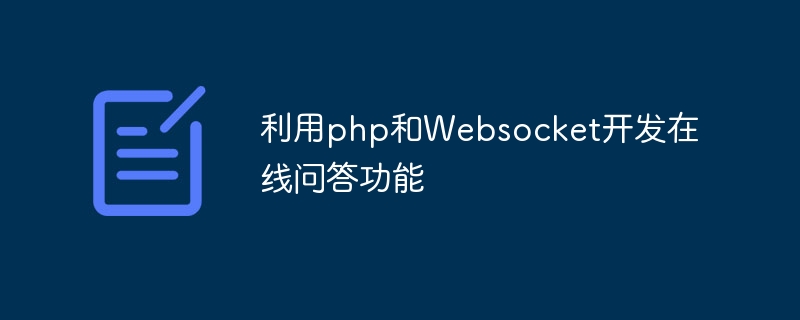

Title: Online Q&A function implementation and code examples developed based on PHP and Websocket
With the development of the Internet, more and more applications need to achieve online interaction Function. Using Websocket technology, real-time, two-way communication can be achieved, giving applications a better user experience. In this article, we will introduce how to use PHP and Websocket to develop online question and answer functions and provide specific code examples.
1. Introduction to Websocket
Websocket is a communication protocol that runs between a web browser and a server. It allows two-way communication on a separate TCP connection. This means that data can be communicated in real time between the client and the server, without the need to constantly send requests to the server, reducing the waste of network bandwidth. Websocket is part of HTML5, and all major browsers support this protocol.
2. Online Q&A function
The online Q&A function is an important application used in education, consultation, social networking and other fields. This function allows users to submit questions and receive timely answers, and online communication can meet users' needs for quick problem solving. In this article, we will introduce how to use PHP and Websocket to implement online question and answer function.
3. Running environment
Before starting to develop the online question and answer function, you need to prepare the following development environment.
Operating system: Linux or Windows.
PHP version: 5.4 or above, and install the php-websocket extension.
Web server: Apache or Nginx.
Browser: Chrome, Firefox, Safari or Opera.
4. Implementation process
In PHP, the Websocket server can be quickly implemented using the php-websocket library. Use the following code to create a Websocket server.
require_once 'Websocket.php';
$ws = new Websocket('0.0.0.0', '9000');In the above code, the Websocket class accepts two parameters: IP address and port. The IP address specifies the network interface the server is bound to, 0.0.0.0 represents all network interfaces, and 9000 is the service port. By creating a Websocket object, you can start the Websocket server.
The Websocket server needs to process new connections after receiving a connection request. The function that handles new connections can be implemented with the following code.
function onOpen($clientId, $data) {
// 处理新连接
}In this function, $clientId represents the ID of the new connection, and $data is the data sent with the connection. New connections can be handled in the function and a welcome message is sent to the client.
After the connection is established, the server can receive messages from the client. Define the following function to process the message:
function onMessage($clientId, $data, $type) {
// 处理收到的消息
}In this function, $clientId represents the client communicating with the server, $data contains valid data from the client, and $type represents the type of transmitted data. Messages from the client can be processed in functions and replies can be sent to the client.
The validity of the data should be verified before sending a reply to the client. In the following code snippet, you can use selectedClientId to determine whether to send a reply to all connected clients.
function onMessage($clientId, $data, $type) {
// 处理收到的消息
foreach($this->clients as $id => $clientSocket) {
if ($id != $selectedClientId) {
$this->send($clientSocket, $data);
}
}
}In the above code, use a foreach statement to iterate through all connected clients, and if the ID is not equal to the selected ID, send the message to that client. Custom logic can be defined for message replies based on the needs of the application.
5. Close the connection
When the client closes the connection, the server needs to perform some operations. Defined the following function to handle the closed connection event:
function onClose($clientId) {
// 处理关闭事件
} In the above code, $clientId represents the closed client connection. You can perform some additional operations before reclaiming server resources.
5. Specific implementation of PHP code in Websocket
The following is a basic Websocket server program.
require_once 'Websocket.php';
class WebSocketServer extends Websocket
{
protected $clients = array();
public function __construct($ip, $port) {
parent::__construct($ip, $port);
$this->clients[] = 'server';
echo "Server started at $ip:$port
";
}
public function onOpen($clientId, $data) {
echo "New client connected ($clientId)
";
$this->clients[$clientId] = $clientId;
$this->send($clientId, "Hello $clientId!");
}
public function onClose($clientId) {
echo "Client disconnected ($clientId)
";
unset($this->clients[$clientId]);
}
public function onMessage($clientId, $data, $type) {
$this->send($clientId, "Received: $data");
}
}
$server = new WebSocketServer('0.0.0.0', '9000');
$server->run(); The above code defines the WebSocketServer class, inherits the Websocket class, and implements functions for processing new connections, messages, and disconnections. You can create a WebSocketServer object and start the server using the run() method.
6. Specific implementation of JavaScript code in Websocket
The following is a JavaScript client program used to connect to the Websocket server and implement message sending and receiving.
var socket;
function connectToServer() {
socket = new WebSocket("ws://localhost:8080");
socket.onopen = function(event) {
console.log('Connected');
}
socket.onmessage = function(event) {
console.log('Server Message: ' + event.data);
}
socket.onclose = function(event) {
console.log('Connection Closed');
}
}
function sendMessage() {
var message = document.getElementById('textInput').value;
socket.send(message);
}The above code uses the WebSocket() function to create a Websocket object, and uses onopen, onmessage and onclose event handlers to implement connection, message and closing processing. The sendMessage() function sends the message in the text box to the Websocket server.
7. Summary
This article first introduces the basic principles of the Websocket protocol, then describes in detail the process of developing online question and answer functions using PHP and Websocket, and provides a complete code example. Using Websocket technology, it becomes easier to develop and implement efficient online question and answer functions.
The above is the detailed content of Develop online Q&A function using PHP and Websocket. For more information, please follow other related articles on the PHP Chinese website!




